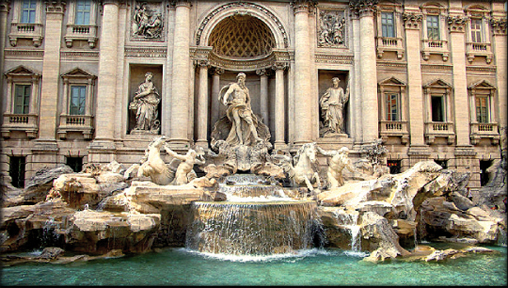 by Hemakumar Nanayakkara
Trevi Fountain is an impressive
monument, made of marble at the small Trevi Square in Rome, Italy. It's
the main attraction of this particular square in the heart of the
Italian capitol and its location is not far from the famous 'Spanish
Steps'.
This beautiful fountain is situated at a junction of three roads and
is the end point of the 'Aqua Virgo' which was a 19 BC aqueduct that
supplied water to ancient Rome.
 The name of the Trevi Fountain is derived from the word "Trivium"
referring to the three roads that converged at this place. The name of the Trevi Fountain is derived from the word "Trivium"
referring to the three roads that converged at this place.
The ivory colour, elegant structure of Trevi Fountain is 25.9 metres
high and 19.8 metres wide, it's believed to be the largest and most
attractive Baroque fountain within the borders of the city of Rome.
This fountain was built during 1732 - 1762 according to a design by
Nicola Salvi who won the competition for designing a model for a new
fountain held by Pope Clement XII .
Salvi died in 1751 leaving his work partly completed. Later the
construction of the fountain was completed in 1762 by an architect
called Guiseppe Pannini. A century earlier a previous undertaking to
build a fountain at this place was abandoned after the death of Pope
Urban VII.
The central figure of Trevi Fountain is Neptune, the Roman god of
sea. He rides a chariot which has a shape of a sea shell, pulled by two
sea horses.
Each sea horse is guided by a Triton. One of the horses is calm and
obedient and the other one is rather fiery. These two horses symbolize
the different moods of the sea; more precisely describe the quiet and
the rough sea.
Beside the figure of Neptune, Abundance spills water from her urn and
Salubrity holds a cup from which a snake drinks.
The water at the bottom of the fountain represents the sea. The
building behind the fountain is Palazzo Poli which already existed
before the fountain was built. Later this building was altered a bit to
match the fancy fountain in front of it.
Trevi Fountain became internationally famous among film goers for a
scene in 1960s Federico Fellini's movie 'La Dolce Vita' (The Sweet Life)
when the beautiful Anita Ekberg takes a late night bath in the cascading
waters of Trevi and invites the hero Marcello Mastroianni to join her.
There is a legend that if a visitor throws a coin over the shoulder
into the water of Trevi Fountain, it will ensure the return to Rome.
Newly married couples visit this place, turn their backs to the fountain
and throw coins over their shoulders into the water for their loves to
remain forever in Italy. About 3,000 Euros worth of coins are daily
thrown into the Trevi Fountain. This money is collected every night and
used for the benefit of the city. |

